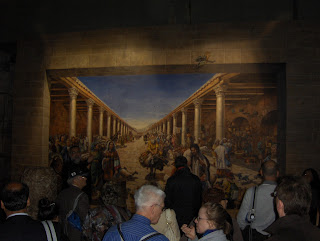It is Thursday and I am sitting in the lobby of the hotel overlooking a very angry Mediterranean Sea. The tail end of the storm is coming through, with 20+ MPH winds and some rain. Forecast is the same for tomorrow, before becoming clear and 60's for the next week or so. Jeanne and I discussed taking tomorrow off after going pretty much non-stop all week. Jeanne is finishing up her HP event today in Caeserea, and will officially begin her vacation tonight.
Yesterday, HP sponsored a first class tour of parts of old Jerusalem. 3 buses took all the HP event attendees to historically rich Abu Ghosh (among others, it is the site of the home of Abinadab, where the Jewish Ark of the Covenant was kept for 20 years until King David took it to Jerusalem.) about 10k outside of Jerusalem. We had a spectacular lunch that included some of the best grilled meats that we have had since arriving. By the way, the bread here is the best I have ever had, and they serve lots and lots with every meal. After lunch we boarded our buses and circumnavigated the old city, driving over Mt Scopus and down through the base of the Mt of Olives (where we hope to spend a day this weekend). We arrived at the Jewish Archealogical Park (http://www.archpark.org.il/index.asp) and toured one the largest major excavations in the world. As you walk through the park, you see layer upon layer of world history exposed, thousdand's of years, one built upon the other. Because the depth of history is too lengthy to even begin to blog, use the park link above to get a great overview of how the original city of David, and the ruins of the temples were uncovered.
The original steps to the temple are shown here. Alternating one short step (12') and one long step (35'), it was designed to slow a person down when ascending the stairs
so that they would approach the temple with reverence.
so that they would approach the temple with reverence.
The giant stones piled at the bottom of the recently excavated wall, lie where they fell when the Romans (under General and later Emperor Titus) destroyed Jerusalem and the temple in 70 AD.
Every stone of the temple was pulled down except the massive corner stones of the Herodian Temple. (Looking at the SE corner) Weighing in excess of 300 tons (ten times the weight of the largest stone that built the pyrimids, as told by our guide), the Romans were unable to move them. It is unknown how the stones, which were quarried elsewhere, were transported and set perfectly in place.
The stones on right side were cleared away during the excavation, revealing the walkway that was crushed by the falling stones.
Looking up at the S E corner as it is today.
The lighter color of the stones at the bottom show the depth of the excavation of this corner and upward, the different layers of construction over the ages.
From there we went went through an ancient market place that was adjacent to the temple
An artists depiction of what this market place probably looked like.
We then went back up to the city proper and made our way to the Church of the Holy Sepulcher. It is here that many scholars feel is the likely site of Jesus Crucifixion, Death, Burial and Resurection. Per the Oxford Archaeological Guide of the Holy Land, the most import argument of this sites authenticity is the consistent and uncontested tradition of the Jerusalem community, which held liturgical celebrations at this site until 66 AD. What is considered to be one of the most holy sites in Christendom, it boggles the mind that, although no one controls the entrance, the door to the church is unlocked and locked each day by Muslims. 6 groups struggle to maintain control of the church (Latin Catholics, Greek Orthodox, Armenian Orthodox, Syrians, Copts and Ethiopians. To this day, they watch each other suspiciously for any infringements of the rights to the church.
Upon entering, you find the Stone of Anointing,
traditionally held as the spot that Jesus body was prepared for tomb by Joseph of Arimathea. After a climb up a steep circular staircase, you come to the stone hill of Golgotha, and the shrine that encases it. Under the center of the shrine there is a hole large enough to reach your arm and and touch a rectangular hole in the stone (which I did) that is said to have held the cross. If you look to the left and right of the shrine, you can see top of Golgotha through the glass encasements.
The hill itself extends down deep into the lower levels of the church.
Below is the Tomb of Christ. Buried by Hadrian in 135 AD to make a level base for his Capitoline temple, it was excavated by Constantine in the early 300's at the request of Macarius, Archbishop of Jerusalem. The excavation was documented by historian Eusebius, and identified as the tomb of Jesus (Graphiti may have identified the tomb of Jesus as it did the tomb of Peter in Rome). Subsequently, the tomb was cut away from the stone cliff to isolate and protect it. Over the ages, the tomb collapsed, and is now encased in polished marble.
Peace,
Mike










WOW! what a day! great job on this blog!
ReplyDelete